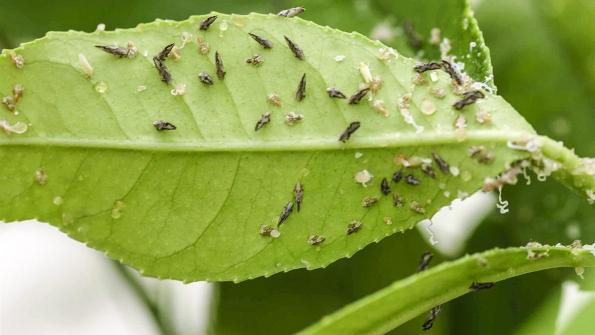
California officials have quarantined a 148-square mile area in Kern County for the Asian citrus psyllid after recent discoveries of the pest were confirmed in urban Bakersfield neighborhoods.
The quarantine zone covers much of south Bakersfield and does not contain any commercial citrus groves or citrus packing sheds, according to Kern County Ag Commissioner Ruben Arroyo.
The quarantine is bordered on the north by New Stine Road; on the east by S Vineland Road; on the south by Millux Road; and on the west by Interstate 5. This area is in addition to the previously announced quarantine areas in Kern County. A map is available online at: www.cdfa.ca.gov/plant/go/acp-quarantine.
In addition to quarantines in portions of Kern, Fresno, and San Luis Obispo counties, ACP entire-county quarantines remain in place in Imperial, Los Angeles, Orange, Riverside, San Bernardino, San Diego, Santa Barbara, Tulare, and Ventura counties.
ACP quarantines are pending in Santa Clara County and San Joaquin County as psyllids were recently discovered in San Jose, Manteca and Lodi.
The ACP is an invasive species of grave concern because it can carry the disease Huanglongbing (HLB), also known as citrus greening. All citrus and closely related species are susceptible hosts for both the insect and the disease. There is no cure once a tree becomes infected. The diseased tree will decline in health until it dies.
HLB was detected in California in 2012 on a single residential property in Hacienda Heights, Los Angeles County. HLB is known to be present in Mexico and in parts of the southern U.S. Florida first detected the psyllid in 1998 and he disease in 2005, and the two have been detected in all 30 citrus-producing counties in that state.
The University of Florida estimates that the disease is responsible for the loss of more than 6,600 lost jobs, $1.3 billion in lost revenue to growers and $3.6 billion in lost economic activity. The disease is present in Georgia, Louisiana, South Carolina, and Texas. The states of Alabama, Arizona, Hawaii, and Mississippi have detected the pest but not the disease.
Residents in the area who think they may have seen ACP or symptoms of HLB on their citrus tree are urged to call CDFA’s Pest Hotline at 1-800-491-1899. For more information on the ACP and HLB, please visit: www.cdfa.ca.gov/go/acp.
About the Author(s)
You May Also Like






